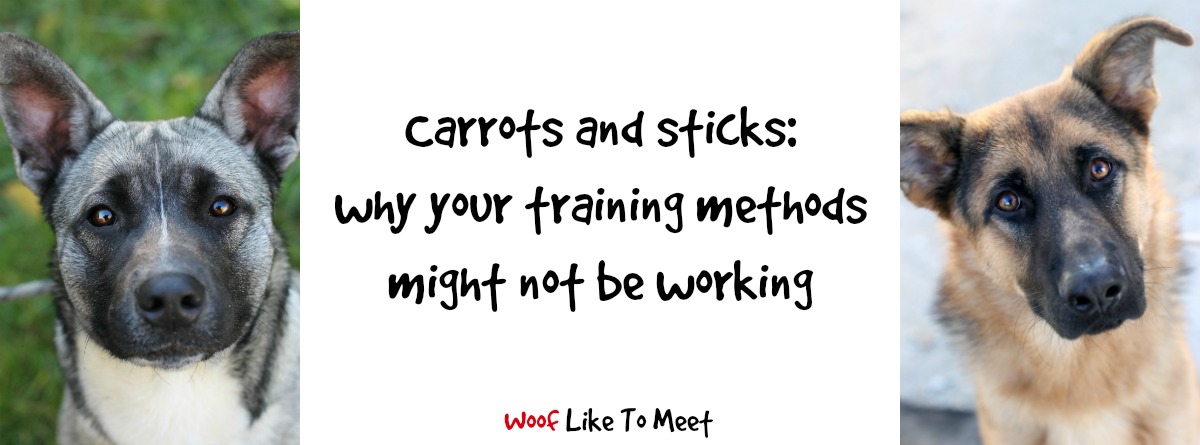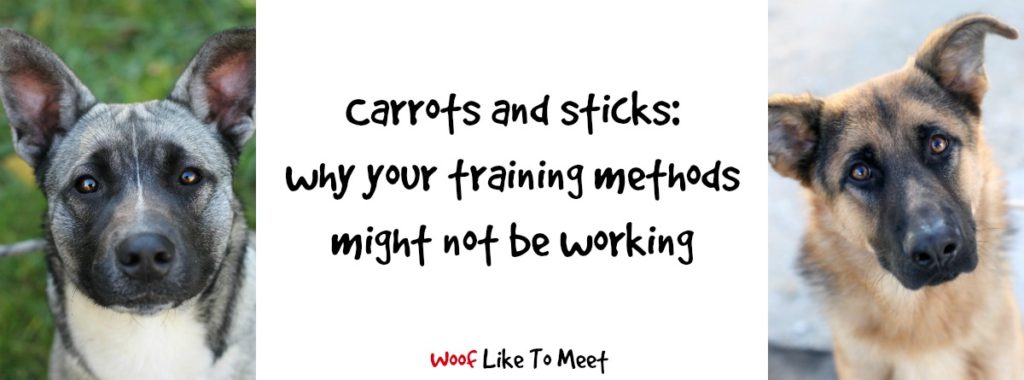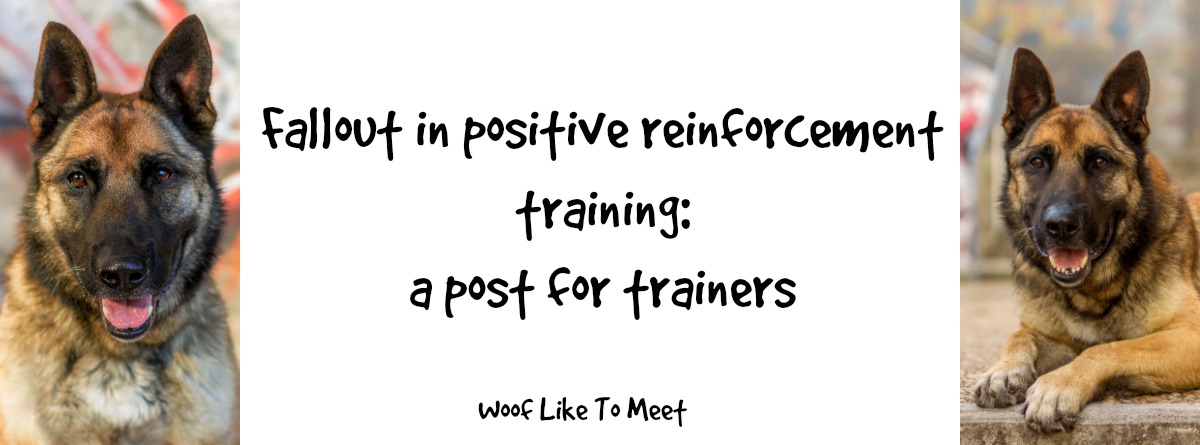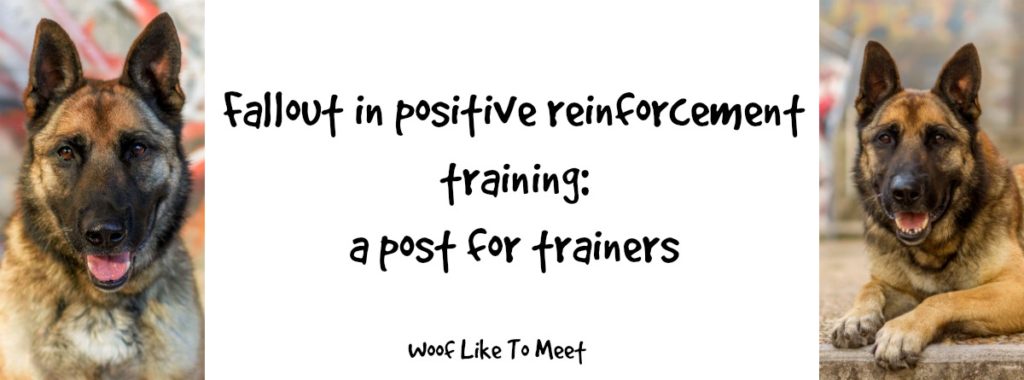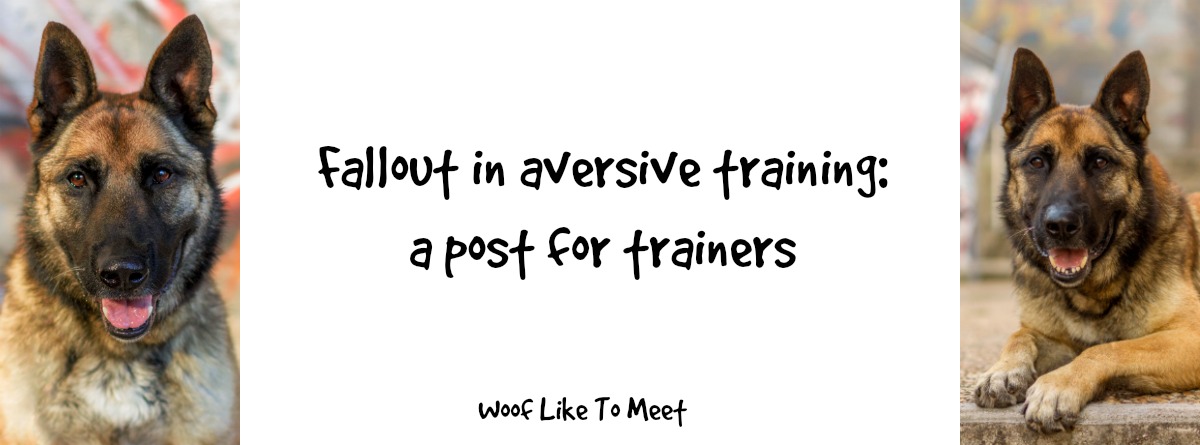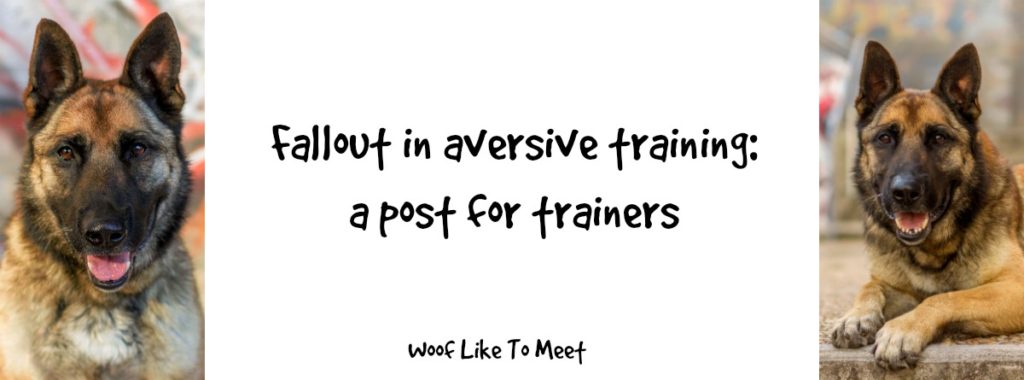One thing I hear often in the world of dog training is that if you put three dog trainers in a room, the only thing that you’ll get two of them to agree on is that the third is doing it wrong. It’s a phrase that’s used often by trainers who are trying to excuse the fact that the world of dog training is mired by conflict and controversy.
To be honest, it’s not true at all. There are many, many trainers I agree with 100%. Many of them don’t just train dogs. When you’re talking to someone who trains killer whales, you aren’t talking about right and wrong, you’re talking about what works and what doesn’t. There are different ethical discussions, sure, but what it comes down to is what works, to what degree it works, and whether it continues to work without fallout. All I’m interested in is what works, how effective it is and what the consequences of it working are.
That’s all I want to talk about today: what works and how effective it is.
Whenever we ask about effectiveness, we should also always ask: “Is it ethical? Does it have emotional fallout? Are there other ways I could train this behaviour that have less potential fallout?”
When you stop asking if everything is right or wrong and focus on whether it works and whether it’s ethical, you stop having those arguments with other dog trainers and you start agreeing much more.
For instance, at a local event, I was in the happy company of one of my favourite local dog behaviourists and trainers, Lydie. We had one of those eyebrows-and-looks moments over another trainer’s methods. It wasn’t a ‘right or wrong’ moment, but a ‘it doesn’t work’ moment. And that we can agree on. Our raised eyebrows weren’t ‘right or wrong’, but over the fact the methods were counter-intuitive and running against the grain of what is effective.
You all know I disagree with aversive, coercive, forceful or punitive methods. But people call me all the time with their dogs who are trained in those ways. Mostly, they are calling me because those methods aren’t working, and I have to get to the bottom of why. I don’t judge them for using them: if I turned away every client who had used aversives with their dogs, I’d have no clients. And I’m sure trainers who say they are ‘balanced’ or use coercion get plenty of calls from people who have tried using food or reward-based training and had problems.
A bit of empathy is always required alongside a lot of problem solving. We’re all just trying to change behaviour in the best way we know how. Mostly, why people choose coercive methods is just lack of knowledge about more efficient ways to achieve the same ends without emotional fallout that essentially leaves our dogs unable to trust us. Often, people choose unpleasant methods because of that never-ending tide of well-meaning but inexpert advice from every single person out there who thinks they know how to change animal behaviour. You know, the well-meaning people who’ve been to one or two training classes back in the 90s and suggest you put an electric fence in if your dog is getting out. Chokes, shocks, raised voices, electric fencing, weird ‘interrupter noises’ like Cesar Millan’s famous ‘tssst’, water sprays, citronella collars, and physical manipulation are so often recommended that you’d think they work. I know I don’t have to tell you that we get a number of dogs who turn up at the pound with an electric collar on to stop them escaping…. or who arrive with worn-down teeth from being tethered, or even who arrive with the tether itself. And I don’t need to walk far around our local parks to see people popping, jerking or yanking a choke chain with absolutely no change in the dog’s behaviour.
What’s that famous quote about insanity?
Doing the same thing over and over again and expecting different results.
I’m sure the person popping a dog’s choke collar ten times a minute and offering treats for good walking was expecting different results. But ultimately, the dog was still pulling, still walking out of the heel position and still more interested by the other dogs than by his owner.
It’s the same for the people who I hear saying “No! No! No! No! No! No! No!” with their reactive dog.
If it was working, they wouldn’t need to do it.
But when clients call, it’s important to get to the basics: is the thing you’re doing – whatever that may be – working with your dog?
So if someone tells me they’re using electric fencing to stop escapes, I ask, “How’s that working out for you?”
You might hear sarcasm. It’s not intended. I genuinely want to know. Is it working?
Sometimes they say that it is. And if I see before me a happy, healthy dog who is full of joy, then I move on. There are other battles to pick and I understand the complexities of trying to teach a dog to stay on the property. I’d prefer a lovely fence and some shrubbery, but if electric fences are working and are not having emotional fallout, then so be it. I’ll never recommend electric fencing myself as I think it can have unintended side-effects, and I might point out some of the potential bear-traps of electric fencing, but that’s not the problem they’re calling for. And if their dog is anxious, upset or shut-down, we’ll have a discussion about how that fence could be contributing to that.
Mostly though, the aversives haven’t worked, which is why they’re calling… and business is brisk, which means those aversives fail pretty often.
Choke chain and verbal reprimands not working with a dog who is reactive around other dogs…
Electric fencing that is not working with a dog who is an escape artist…
Spraying with a citronella collar not working to interrupt humping…
Banging on the crate and saying “no!” not working for a dog who is howling in a crate…
Spraying a dog in the face with a water spray not working to stop in-house canine conflict…
Kneeing in the chest not working with a dog who is jumping up…
And there are lots of times when people think that what they are doing is working, when it quite clearly isn’t. People using choke chains with dogs who are still pulling, for example, or bark collars on dogs who are still barking.
It works the other way too. It’s not just aversives that fail.
Squeaky toy not working with a dog who has poor recall…
Food not working with dogs who are barking…
Food use ending in greedy dogs who mug their owners…
Toys becoming a source of obsession and frustration…
Dogs who won’t do something unless you bribe them…
So why do our attempts to change behaviour fail so often? And yes, it is often, otherwise all our dogs would be PERFECT! I think they are perfect as they are but I’d be dishonest if I didn’t wish Heston didn’t bark so much, that Tilly didn’t feel the need to roll in stinky stuff and Amigo wasn’t quite so shut down on the lead. And I wouldn’t volunteer at a shelter where
Behaviour is SO simple. SO, so ridiculously simple. You’d think we wouldn’t need it explaining to us, it’s that simple. It’s so straightforward to understand that you think it’s a trick.
What is behaviour? And how does it develop?
There are two main types of behaviour: reflexive, automatic, physiological, emotional, unconscious, involuntary behaviour (sometimes called Pavlovian, classical or respondant) and conscious, reflective, voluntary behaviour (sometimes called Operant). These are intertwined in a kind of chaotic Gordian Knot. Sure, we have automatic, emotional physiological responses (like the look of disgust I give from time to time or the way my eyes go big when I don’t believe something) that are often emotional, but not always, like goosebumps and shudders, salivating and blinking when air is blown in our eyes, but these behaviours function in the same way as conscious behaviour.
Behaviour can only do two things.
Increase (or maintain)
Decrease (or disappear)
And that, my lovely readers, is behaviour in a nutshell. Not so complex is it?
In order to have one of those two outcomes, I can use two methods to bring it about.
Let’s take the crazy circling that Heston does before a walk. That behaviour is a response to me locking the door. It can only go one of two ways. He can either circle more (or keep doing it at the same frequency, intensity and duration), or he can circle less (or stop completely). If I change nothing, that behaviour is probably going to stay the same. I lock the door, he circles, we go for a walk.
So how do I increase or decrease voluntary behaviour?
There are really only a small handful of methods.
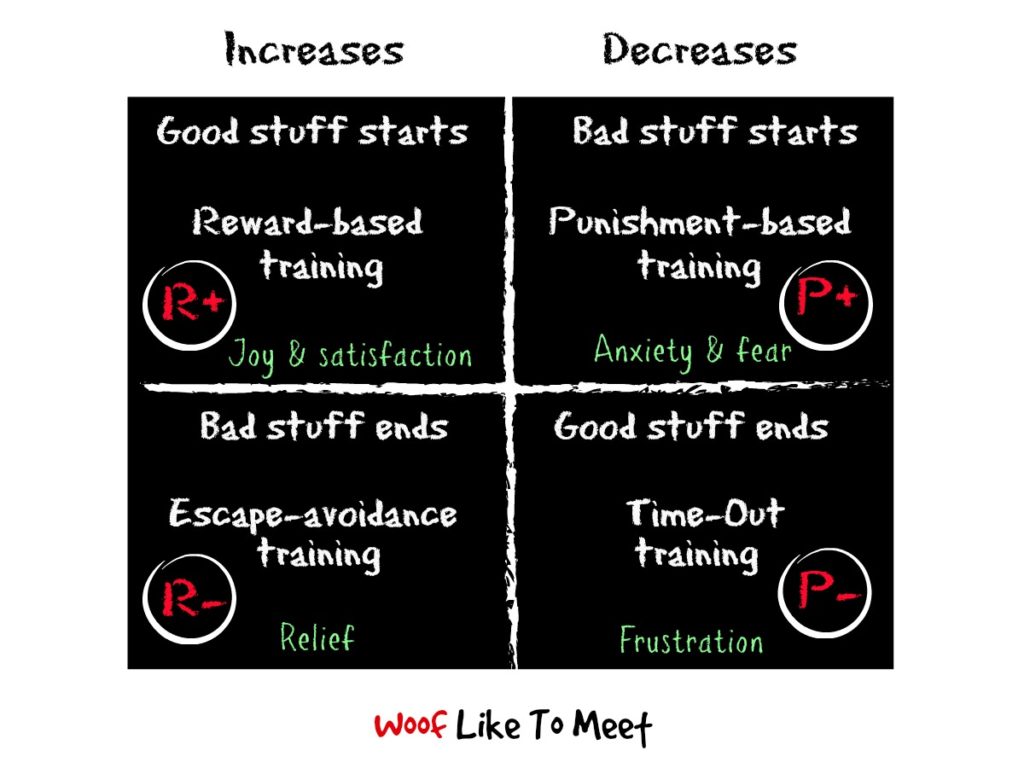
This is adapted from the work of certified animal behaviourist Kathy Sdao and canine behaviourist Maureen Backman.
So often, clients tell me they want behaviour to decrease. They want their dog to stop barking, to stop pulling, to stop biting, to stop chewing.
Because as human beings, our natural modifiers are sticks rather than carrots, we think the same is true of animals too… that the bad stuff is the best way to teach. This flies in the face of science and experience, which teach us the best ways to increase behaviour are by starting the good stuff, and keeping it going.
Sometimes, that means we have to change how we phrase things … “I want my dog to heel more… I want my dog to have increased calm… I want my dog to chew appropriate things” instead of saying “I want my dog to stop pulling… stop barking… stop chewing…” and it also means we have to think about the methods we use to get that increase.
My main problem with decreasing behaviours is that it has one huge, glaring issue.
We spend so long wanting to decrease behaviours that pretty much our animals would be lying around in a sleepy heap most of the day. The dogs that people describe to me, the ones who don’t jump, who don’t bark, who don’t chew, who don’t engage with the world, who don’t pull… they sound like stuffed toys rather than real dogs. We do our dogs a disservice to expect them to have no behaviours at all. What do we want a dog for if we don’t want it to be a dog?
Also, I’m of the opinion that behaviour abhors a vaccuum. Have you ever tried to just sit and do nothing for more than 30 seconds, not sleeping, not moving, not fidgeting with your hands? Imagine if your only option was sleeping, but you were more than well-rested? I think that would drive me crazy. Even meditation or mindfulness is focused ‘doing nothing’.
But we often, by eliminating or decreasing our dogs’ behaviours, give them few things that we want them to do instead. That’s when they become self-employed and start doing other behaviours that dogs do to occupy themselves… digging, foraging, wandering, barking, chewing, jumping, spinning, circling, tail-chasing, licking, flank sucking… not all of those canine behaviours are productive, and several are a well-recognised sign of distress in animals.
That’s why I ask my clients to rephrase what they want, thinking about what they want to increase.
It’s also why I tell them they can’t ask to increase ‘dead men’s behaviours’ – are you asking to increase things a dead man could do? Lie still, be quiet, stay on the bed. All things a dead man could do.
So if I wanted to change Heston’s circling, I have to think of several questions:
“What behaviour do I want to increase?”
That means coming up with a behaviour that is not circling that I want him to do instead.
I ask myself for a replacement behaviour that has the same function as the other.
I have to ask myself, “what function does the circling have?”
I think that it is partly frustration, as he wants me to stop locking the door and start the walk. It is partly excitement and over arousal. It is partly a way to get rid of a burst of over-excitement. It feels good and, as anyone who’s ever spun until they’re dizzy will attest, it gives you a sense of euphoria. It feels good. So I need a behaviour that is equal to this. He needs to do something that gets rid of that burst of over-arousal, something that feels good, something that gives him a feeling of euphoria. So I get a big bag of his favourite squeaky rugby balls. I teach him “Find it!”. I hide a rugby ball in the yard before the walk and I tell him to “Find it!” so that I can lock up in peace. By the time he has his ball, I am ready to go and the circling is no longer. The best thing about this is that it’s also dealt with his excitement barking and also my own frustration at trying to manage getting all the dogs out of the door.
Coming back to “does it work?” – the proof is in the pudding. It does work. Using food wouldn’t work here because dropping treats on the floor is not going to give him the sense of euphoria even if it dissipates his arousal burst. I use this sometimes, but it depends on the dog. Putting him on a tight lead before we go out of the door and bopping him on the nose if he tried to circle may also work, but I bet I’d see the circling move up the chain, if you like. I’d see that circling before I put the lead on him, in the house. As soon as he realised a walk was on the way, I’d still get the behaviour because bad stuff never addresses the reason why the dog is doing the behaviour in the first place. And because aversives may lead to the animal putting distance between themselves and the handler, I would predict that he would be harder to put on the lead and be less likely to approach me to have it put on until he’d stopped circling.
This is also why you’ve got to think of the individual dog. What is it that motivates them? One of my shelter dogs was happily jumping and bopping handlers on the face before walks. Same function, different behaviour. What replaces bopping and greeting? First, five minutes of a low-down face-to-face greeting where she doesn’t have to jump to say hi, and then lots and lots of hand-targetting. She loves to bop with her nose, and a hand target is a great way to have a bit of a bop. Hand-targetting, is, guess what, great for heel walking and getting dogs in position as well as preventing them from jumping (or also redirecting them away from your face) and that’s why every bit of “good stuff” is as individual as your dog.
When it comes back to it then, whilst there will be trainers out there who would do alternative things instead of “Find it!” or hand-targeting, really, those of us who know about behaviour know that we have a few simple routes open to us. How we get there may be different – we can use the whole world of doggie “good stuff” to meet the same ends. We may do things differently, but we don’t disagree. We know that you need to use good stuff to increase behaviour and that this has the fewest side effects. There is no disagreement about that unless you don’t have a grasp on how animals learn.
Where Lydie and I may have sometimes different methods or different approaches, the result is the same.
That’s not to say I couldn’t pick other training methods. They’re things that just end in emotions that aren’t particularly conducive to the relationship I want with my dog. Nor are they as effective.
I guess I could use time-outs to decrease the circling – go back in the house, go out of the kennel, turn to stone until the behaviour stops, but that is why I stuck those feelings on the diagram … frustration is not so fun when you are dealing with an animal. Though I think it absolutely vital to teach dogs to tolerate frustration and to be able to “do nothing” (as all three of mine are doing as I write this), an over-excited animal is going to find some other behaviour for the emotions behind what they are doing, and I don’t want to add frustration to the mix. When you deliberately choose methods that rely on a feeling of frustration to increase a behaviour, and you do so with a dog, you should expect that frustration to pop out in other ways. For dogs, that is normal in a fair few ways, including barking, jumping, pawing, leaping, but also biting. Displacement bites and frustration bites are far too common, because witholding the good stuff depends on frustration to change the behaviour.
Coming back to the central premise of this article, it’s clear to see why I think it’s carrots all the way. The good stuff is not without its pitfalls, but the pitfalls are much less severe than the bad stuff. That’s why, if you put me in a room with two other trainers, if they understand behaviour, then we’re all in agreement. You can’t argue with outcomes.
What always depends is what the dog understands to be good stuff (and this is where basic trainers can get trapped into very limited thinking) and whether that stuff is good stuff at that moment in time. Food is not the only tool in my toolkit, and a good trainer will be thinking of scent, play, touch, behaviours, interactions, praise and functional behaviours in the “good stuff” camp too. What many beginners fail to get their head around is that many of the ‘good things’ we tend to use with dogs need to be taught. Praise is meaningless to a dog who doesn’t understand it, and likewise touch. At times or with certain dogs, touch can fall solidly into the “bad stuff” camp. Ironically, the stuff that dogs don’t need to be taught to enjoy, things like chasing a rabbit, flirting with the opposite sex, rolling in dirt, smelling other dogs’ urine, are the icky things that many trainers wouldn’t even consider using to shape behaviour. And there are things dogs enjoy themselves which they have learned pay off, like the crinkle of a crisp wrapper. There are things that a dog would consider to be “good stuff” having been taught, like laser pens, but that many trainers wouldn’t use because of the risk of compulsive behaviours.
So if your training method isn’t working, one of the common reasons is relying too much on punishers that are ineffective. Another can be choosing either positive or unpleasant stuff and keeping doing it even if it’s not having an impact on behaviour. Expecting to always decrease behaviour and ending up with the equivalent of a dead dog is another reason training using aversives can go wrong. If you don’t address the function or emotion behind the behaviour, you’ll probably not succeed in the long term in making any behavioural changes.
One very big reason why training doesn’t work is in mixing and matching the good stuff and the bad stuff. Whilst I have my own feelings about aversives, there are some really, really powerful reasons you shouldn’t mix the two. So if you’re going to use aversives, then use aversives, but the ‘balanced’ training is a complete fallacy for reasons which deserve a post of their own. You either go with the good stuff or the bad stuff, but if you mix and match, you may certainly not get the results you want. So if you use punishers, aversives, shocks, prongs, chokes or other unpleasant things such as sprays or ‘interrupters’, make very sure you only use those. Behaviour is not a pick and mix.
In the next post, I’ll look at how training goes wrong when you mix and match the good stuff and the bad stuff – the potential side-effects of using both the carrot and the stick in the same sessions. There are some very big reasons for not using the two together that are worth exploring in full, which might explain more why I’m so skeptical of ‘balanced’ trainers who use both methods without clear distinction.

